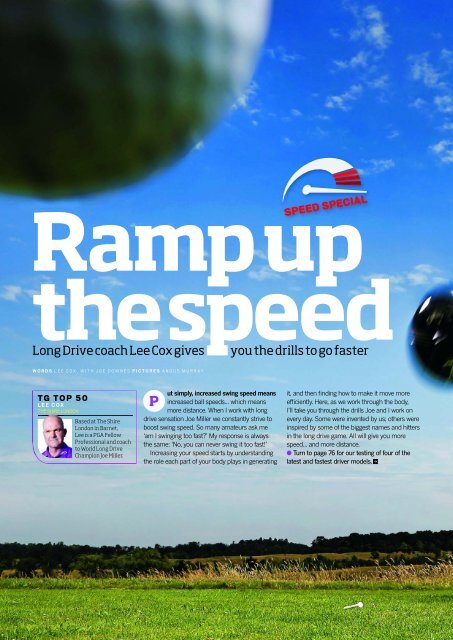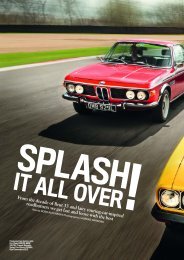Today's Golfer 338.pdf
- No tags were found...
Create successful ePaper yourself
Turn your PDF publications into a flip-book with our unique Google optimized e-Paper software.
Ramp upthe speedLong Drive coach Lee Cox gives you the drills to go fasterSPEED SPECIALWORDS LEE COX, WITH JOE DOWNES PICTURES ANGUS MURRAYTG TOP 50LEE COXTHE SHIRE LONDONBased at The ShireLondon in Barnet,Lee is a PGA FellowProfessional and coachto World Long DriveChampion Joe Miller.ut simply, increased swing speed meansP increased ball speeds... which meansmore distance. When I work with longdrive sensation Joe Miller we constantly strive toboost swing speed. So many amateurs ask me‘am I swinging too fast?’ My response is alwaysthe same: ‘No, you can never swing it too fast!’Increasing your speed starts by understandingthe role each part of your body plays in generatingit, and then finding how to make it move moreefficiently. Here, as we work through the body,I’ll take you through the drills Joe and I work onevery day. Some were invented by us; others wereinspired by some of the biggest names and hittersin the long drive game. All will give you morespeed... and more distance.O Turn to page 76 for our testing of four of thelatest and fastest driver models. ➔
BOOST YOUR SWING SPEEDLowerbodyLet’s work from the ground up,focusing on the strike itselfand your legs. Your legs andhips are the engine room ofthe swing, and therefore yourspeed core. The morerotational speed you cancreate here, the faster youcan get your upper body toaccelerate. I’ll show you asimple drill to help you speedup this rotation.As for the strike, some elitefaster swingers, includingmany tour pros, can develop apowerful strike from a slightlydescending attack. However, ifyou swing under 100mph youwill gain more distance fromhitting up through the ball.Again, I’ll show you an easyway to hone that attack angle.The drillA stick or shaft betweenyour belt loops is a greatway of building rotationand speed. Notice how thestick moves behind anddown as I swing back,before rotating quickly inthe opposite direction andrising through impact (right).The moveThe key move on theway back sees the pelvisturn against the rightthigh. This stretches therotator muscles to induceincredibly fast hip rotationin the early downswing.Rory McIlroy is the bestexample of this move.72 ISSUE 338 TODAYSGOLFER.CO.UK
The effectThe left shoulder showshow much power this hipmove has created. Lookhow far it has movedaround and up from top ofthe backswing to impact.People use the analogy of askater who wants to jumpand twist to illustrate it.UP AND AWAYIf you swing at less than 100mphyou need to hit up on the ball; andevery golfer needs to middle it toincrease their ball speed. This drillis really effective with the players Icoach as it tests both. Place two teeseither side of your ball, just widerthan a driver head apart. Hittingeither on the way through meansyou’re not hitting it out of the centre.Place another tee one grip-length infront of the ball, adjusting the heightto increase the upwards angle ofattack. The club should miss thisfront tee – hitting it means you arenot hitting up on the ball enough.➔TODAYSGOLFER.CO.UK ISSUE 33873
BOOST YOUR SWING SPEEDTorso, arms and handsThe leg and hip movement rotate the torsowhich begins to work the arms and hands.From here, swing speed is generated byhow fast you can move your left arm andshoulder through the swing and your cluband body’s range of motion. These four keypositions for your arms and hands willincrease your speed as they all store powerthat you can unleash at impact. In short,for maximum speed and power your swingneeds to be wide in the backswing, narrowin the down swing and wide again after impact.Wide takeawayMaximising the width of your swing is crucial and it starts with thetakeaway. Extend your arms fully, feeling as though the right arm(right-handers) is stretching the left away from the ball.Bounce itRelax your wrists and let the shaft bounce off your shoulder. This wasthe top drill of long drive legend Jason Zuback. This narrowing on thefirst move down creates more lag and faster downswing rotation.Relaxed wristsLoosen your wrists to create more wrist cock at the top of thebackswing. This will help you create that speed-increasing lag as thewrists uncock and then rotate at greater speed through impact.Right arm throwThis is the signature move of Long Drive record holder Mike Austin.Shifting your pelvis towards the target allows your right shoulder tomove down which lets the right elbow get to the hip before the hands.74 ISSUE 338 TODAYSGOLFER.CO.UK
ShouldersThe final part, and probablythe most important, is the leadshoulder. All the moves wehave covered so far are toincrease the shoulder’s rangeand speed of movement. It isthis part of the body thatincreases swing speed morethan any other, as the rotationthat you have built up at thestart of the swing allows theshoulder to overtake the speedof your pelvis and torso by themiddle of the downswing asyou approach the ball. Here’show to increase it...TOTAL PACKAGESwing back on one leg beforeplanting your lead foot hard into theground just before impact. This drillheightens the feeling, speed andrange of motion in everything we’veworked on – legs, hips, arms, handsand shoulders. Joe Miller startssessions with this and has clocked aspeed of 157mph with it.Moving upThe lead shoulder drivesup through impact,increasing speed. Practisethis by swinging the grip ofthe club with your glovedhand only. Lean back alittle as you swing to helpyou balance during thisfast rotation.Lean awayImagine a line runningfrom your lead foot to yournose at address. As youswing, the key is to staybehind this line for theperfect spine angle leaningaway from the ball. Don’tmove ahead of the ball.TODAYSGOLFER.CO.UK ISSUE 338 75
THE TESTFast andfuriousWe pitch four of the fastest drivers on the market in a headto-headpace race. Which will prove the speediest model?SPEED SPECIALWORDS SIMON DADDOW PICTURES TOM CRITCHELL, BOB ATKINS76 ISSUE 338 TODAYSGOLFER.CO.UK
peed is a growing theme inSgolf equipment – and it’s onethat is not going away.Some manufacturers are soobsessed with it they’re designingspecific ranges to wring out every lastdrop of juice from your game.Aerodynamic heads, Turbulators,hosel fins, Speed Pockets andlightweight technology all play bigroles in these designs.These features promise increases inclubhead or ball speed, which ofcourse will maximise distance – butwe wanted to see if they really do whatthey say on the tin. Up until now, TGhas not put the big dogs of speed in ahead-to-head test; so we thought itwas about time we did.What we didWe picked the four drivers that havebombarded you the consumer with themost talk of speedy technology in2015, then we travelled to the NationalCustom Fitting Centre at The Belfry toput them to the test. Each driver hadto have more than one design featureaimed specifically at speed to beconsidered for our test.To get a better understanding of howthis speed technology has evolved, wealso tracked down and hit a driverfrom each manufacturer that was atleast five years old (page 82). Thesedrivers had virtually no emphasis onspeed, so we were able to see howmuch difference today’s modern‘speed’ features bring to the table.How we did itWe fitted professional Chris Ryan intoeach model and he hit shots on aTrackman launch monitor to allowanalysis on how each performed.Equipment Editor Simon Daddow alsohit shots to allow further comparison.We also wanted real world feedback sowe invited four regular golfers to hittheir current drivers against the newmodels to give additional feedback.Pulling all this data, comments andopinions together we chose whichmodel got our speed pick.THE TESTERSChris RyanHandicap: ProTG’s equipment guruCurrent driver: TaylorMade SLDRSimon DaddowHandicap: 10TG Equipment EditorCurrent driver: Callaway FT-3THE READERSRon LlewellyanHandicap: 18Club: Drayton ManorCurrent driver: TaylorMade RBZRumayne StevensHandicap: ScratchClub: WalsallCurrent driver: TaylorMade R15 430Dave HandleyHandicap: 10Club: Society MemberCurrent driver: Titleist 975DMarcus DawsonHandicap: 9Club: Whittington HeathCurrent driver: TaylorMade RBZ Stage II ➔TODAYSGOLFER.CO.UK ISSUE 338 77
THE TESTPing G30 £299Shaft length: 45.75” Stock shaft weight: Regular Flex 55g, Stiff 59g Contact: www.ping.comREADERSHIT THEPING G30AGAINSTTHEIR OWNThe tech storyO Crown Turbulators Six ridges atthe front of the crown are designedto increase airflow efficiency. Bycreating less drag it means golferscan swing at the same speed, butthe clubhead travels faster.Consequently ball speed is quickerand shots fly further.O T9S face New in the G30 is ahigher strength but lighter T9Stitanium face. For golfers this meansless loss of ball speed on shots hitfurther away from the centre. Thisnew alloy deflects and reboundsquicker across the face over Ping’smore conventional 6-4 titaniumfaces.O TFC 419D shaftThe 419D is ahigh balance point shaft whichmeans the centre of gravity is closerto the grip end. This allows Ping touse a heavier head (which increasesthe MOI and lowers the centre ofgravity) meaning essentially aheavier mass impacting the ball…which you’ve guessed improvesball speed.Chris Ryan’s verdictPing seems to have squashed theG30’s head from above, making itwider from front to back than theothers. For me this inspiresconfidence and because of theweight at the back on the sole Iknow it’s going to be high on MOI,which means less lost ball speed onoff-centre hits. The sound at impactis very loud which some golfers willlove as it sounds like you’ve alwayshit a good one. To me the face feelsmore explosive than the otherdrivers and in my opinion this is areally strong package of gameimproving speed technology.Simon Daddow’s verdictPlenty has been said about howthe “Turbulators” on the G30’scrown frame the ball at address,but in all honesty I didn’t reallynotice either of them – or how theG30 doesn’t have an alignmentmark. I like the matt black crown,I like how the head’s slightlyheavier than the others on test soyou know where it is during theswing and I know many golfers willlove the sound. For me Ping hasrolled a heck of a lot into this driver.Yes it has aerodynamic properties,but it still feels and plays like amass market driver. Ping hasn’tgone all out for speed at theexpense of creating a good lookingand performing driver.Ron LlewellyanThe G30 performedadmirably for Ron.A total distancegain of 11.6 yardsis significant andrepresents a fairreflection on howtechnology hasimproved over hisown driver.RumayneStevensReally liked thepowerful low-ballflight he generated.We saw a decent3mph increase inball speed whencompared to hisown driver and700rpm less spin.TurbulatorsCrown ridgesincrease airflowefficiency.Reduced dragimproves clubspeed and totaldistance.Dave HandleyDave felt shotscame off theface of the G30really quickly andpossibly hotterthan with the otherdrivers. Club andball speed wisehis numbers weresimilar to his driver.Chris Ryan’s numbersClub speed: 115.1mphBall speed: 173.0mphLaunch angle: 11.3 degShot height: 97.3 feetBackspin: 3419rpmCarry distance: 283.4 yardsTotal distance: 309.2 yardsMarcus DawsonThere was a themewith the G30 as wesaw it out-performthe golfers owndrivers. Marcusgenerated an extra2mph of ball speedwhich translatedinto an extra fiveyards of carry.78 ISSUE 338 TODAYSGOLFER.CO.UK
TaylorMade AeroBurner £269Shaft length: 45.75” Stock shaft weight: Regular 50g, Stiff 50g Contact: www.taylormadegolf.comREADERSHIT THEAEROBURNERAGAINSTTHEIR OWNThe tech storyO Speed Pocket The Speed Pocketis sound technology. Lots of newdrivers have them, but theAeroBurner’s is twice as long assome of their previous designs,which makes the clubface hotteracross more of its surface. It alsodeflects shock waves back towardsthe face, which for golfers, meanshotter shots when you don’t catchthe centre of the face.O Aero Hosel Engineers make allsorts of patent applications relatedto aerodynamics on golf equipment.Some are so bizarre they refer toshaping the shaft like an aircraftwing in a bid to improve airflow. TheAero Hosel helps control airflow inthe difficult area behind the hosel.Granted this “fin” alone may onlyresult in tiny increases in mph, butas we know with F1 cars every gainincreases overall performance.O Raised centre crown A highcrown and steep back design keepairflow attached to the crown forlonger, increasing efficiency andreducing drag.O Flexible face The clubface canonly deflect at a certain rate if it’s toconform to the rules. TaylorMadeincrease the flexibility at differentpoints around the face so mishitsgenerate better results.Chris Ryan’s verdictFor the majority of everyday golfersthe lightweight AeroBurner showsgood design principles. It’s notrocket science that if it’s lighter, youcan swing it faster. But for me harderhitters can struggle with extremelylightweight designs. Personally I lovethe white head and black face, it’sreally easy to aim and frames theball perfectly on the tee. I createdmy quickest club and ball speedswith the AeroBurner, but never quitefelt I had it under control.Simon Daddow’s verdictThere’s no arguing the AeroBurnerlooks great behind the ball – thewhite crown works. To me it feelslike there’s weight high in the shaft,towards the grip, which takes awaythe sense of where the clubhead isduring the swing. I hit a decentnumber of good drives with theAeroBurner, but the lasting feelingwas that any speed or distance gaincame at the expense of consistency.Ron LlewellyanOur data suggeststechnology hasmoved on quicklyas Ron gained1.3mph in clubspeed and aimpressive 9.6yards of totaldistance with theAeroBurner.RumayneStevensCompared to hisown R15 Rumaynemade significantimprovementsacross the board– gaining 3mphof club speed and6mph of ball speed.The tech works.Raised crownA high crownand steep backimprove airflowefficiency,reducing drag –as does the ‘AeroHosel’.Dave HandleyDave hit theAeroBurner a littlehigher than his owndriver so lost a littlebit of run. But hegained 5mph ofclub speed, 1.5mphof ball speed andan additional 3.4yards of carry.Chris Ryan’s numbersClub speed: 118.5mphBall speed: 173.5mphLaunch angle: 11.4 degShot height: 105 feetBackspin: 4722rpmCarry distance: 280.6 yardsTotal distance: 299.4 yardsMarcus DawsonMarcus postedsome decentnumbers withit compared tohis two-year-oldRBZ. A ball speedincrease of 2.1mphand three moreyards in total is notbad at all. ➔TODAYSGOLFER.CO.UK ISSUE 338 79
THE TESTCallaway XR £279Shaft length: 46” Stock shaft weight: Regular 54g, Stiff 56g Contact: www.callawaygolf.comEXPERT’SCHOICEREADERSHIT THECALL AWAYAGAINSTTHEIR OWNThe tech storyO Speed Step Crown Callaway’stalk of “aero efficiency” describesperfectly how seriously theirdesigners take aerodynamics. TheSpeed Step Crown effectivelyreduces drag just like an aeroplanewing, allowing air to pass over theclubhead more efficiently thantraditional crowns.O Maximum load shaft After goingto such extremes to make the headquicker, a regular 65g shaft wasnever going to be best for the XR.The chosen Project X LZ unusuallyhas a softer mid section. Thisincreases the energy load golfersimpart on the shaft, which naturallyunloads at impact increasing energytransfer to the ball. This in turnmaximises ball speed and distance.O R-MOTO face The amount thecentre of a driver face can act like aspring has been maxed out foryears and is tightly governed by therules of golf. But that hasn’t stoppedCallaway’s engineers trying to raisethe amount of spring you get fromoutside the centre zone. The R-Motoensures efficient energy transferbetween club and ball, whichmeans you lose less ball speedwhen you hit shots off centre.Chris Ryan’s verdictI like the more muted sound of theCallaway over some of the higherpitched drivers – to me it gives theimpression of being powerful. Flightwise, because of the shaft, I felt Ihad better control of the XR thanthe others, especially the superlightweight models. The XR feltmore stable than the other driversfor my game and my Trackmanstats reflected this. I don’t love theaerodynamic steps on the crown,but for ultimate distance I couldn’tbeat it.Simon Daddow’s verdictInitially I wasn’t a huge fan of thestepped crown, it looks to aim a bitright. But after hitting several shotsit really didn’t bother me. Theoverall performance of the XR isreally solid. It sits really nice ataddress, the head shape isunoffensive, it sounds good, there’splenty of speed technology featuresand its adjustable hosel means itcan be tuned to suit your game.Of our four speed drivers we tested,this is the one I’d put in my ownbag.Ron LlewellyanRon’s club speedincreased by1.3mph comparedto his own driver,but critically hisbackspin droppedby over 1400rpm.That meant animpressive gain of16 yards.RumayneStevensLooking at ballspeed alone the XRposted an increaseof 2.1mph, but theclub span more sohe was robbed of afew yards. A shaftsimilar to his own isthe answer.Speed CrownA ‘speed step’improvesaerodynamics asair passes overthe crown, justlike an aeroplanewing.Dave HandleyBy his ownadmission Dave’stiny 1998 Titleistdriver is in needof replacement.The XR improvedhis club speed by2mph and totaldistance by eightyards.Chris Ryan’s numbersClub speed: 117.3mphBall speed: 173.2mphLaunch angle: 11.8 degShot height: 97.6 feetBackspin: 2679rpmCarry distance: 284.2 yardsTotal distance: 311.4 yardsMarcus DawsonThe XR performedbrilliantly in hishands improvingball speed by 3mph(matching some ofCallaway’s Speedincrease claims)and giving him anextra 8.4 yards intotal distance.80 ISSUE 338 TODAYSGOLFER.CO.UK
Wilson Staff D200 £199Shaft length: 46” Stock shaft weight: Regular Flex 44g, Stiff 44g Contact: www.wilsonstaff.comREADERSHIT THEWILSONAGAINSTTHEIR OWNThe tech storyO Right Light Technology Weighingin at just 268g the D200 isremarkably light, the head aloneweighs just 189g. Compared to theG30’s 206g head you don’t need alab coat to see there’s a significantdifference. Wilson says its testingshows golfers of all standards canbenefit from lighter clubs as they’reeasier to swing faster. Granted, it’snot rocket science, but the trickcomes in getting these lightweightcomponents to feel stable andpowerful at impact.O Chemically etched crown TheD200’s crown is chemically etchedto reduce thickness and thereforeweight in certain areas.O Reactive face This increases thesize of the clubface, with the aim ofdelivering specific improvements totoe and heel hits, by reducing anyloss in ball speed.O A 44g shaft When your aim is toproduce an incredibly light club youhave to look at every componentand shave grams off each. Wilson’used the incredibly light USTMamiya Elements Chrome shaft,which at 44g is by far the lightestshaft included in this test.Chris Ryan’s verdictThe first thing I noticed was theweight… it’s so light compared towhat I’m used to. The head is a niceshape and it doesn’t look as wide orsquashed from front to back assome of the others. I’m reallysurprised at how solid shots feltcoming off the face considering thehead is 17g lighter than the Ping.For me the shaft was less stable,which meant I lost a bit ofconsistency but for a club golferthis would be less of an issue.Simon Daddow’s verdictSuper lightweight drivers aren’t anew idea, but it’s a good one. I juststruggled to adjust to the weightdifference between the D200 andmy own driver. With practice thiswould not be an issue and havingwitnessed Rumayne pounding theD200 over 300 yards it’s hard to sayit doesn’t work in the right hands.Super lightEvery componentof the D200 isoptimised to belighter, whichmeans quickerand longer.Ron LlewellyanRon’s lower swingspeed was wellsuited to the D200.His club speed rosewith the lighterweight and with again of 13 yards incarry it’s hard tosay this conceptdoesn’t work.RumayneStevensA 2mph gain inclub speed, 9mphin ball speed anda 13.1 yard gainin total distanceproved lightweightcomponents don’tlimit how far youcan hit it.Chris Ryan’s numbersClub speed: 115.3mphBall speed: 172.3mphLaunch angle: 11.8 degShot height: 110.2 feetBackspin: 4501rpmCarry distance: 281.6 yardsTotal distance: 301.8 yardsDave HandleyA decent increasein club speed,but his ball speeddropped off a little,suggesting he washitting shots offcentre more oftenso the concept wasworking less wellfor this hard hitter.OUR CONCLUSIONThe purpose of our test wasto investigate whether or notit’s possible to buy extradistance with one of the new‘fast’ drivers. Looking at ourdata we’ve got to say yesyou can – all four golfersincreased their distance withsome of the new models.However, if buying speedmeans hitting it off centremore often (because a shaftis longer or you loseaccuracy as you can’t feelthe club) then it’s not aworthwhile investment.Our advice is simple – getfitted for your driver. Seeyour numbers on a launchmonitor, and find out if thedriver is working for you.Then you can decidewhether to buy more speed!Marcus DawsonIn the hands of aslower swing theWilson produceddecent results. An8.3 yards gain incarry over his owntwo-year-old driver(which already hassome light tech) isimpressive. ➔TODAYSGOLFER.CO.UK ISSUE 338 81
THE TESTSmash factorBelfry pro ChrisRyan launches oneof the new drivers.Think technology hasn’t moved on? Think againResearch says the majority of golfers buy a new driver every five years. So we wanted tosee if a five-year-old driver would cost you speed and distance over the latest models...Ping G2Wilson Staff Dd6TaylorMade R5 DualCallaway FT-5The G2 was Ping’s first reallysuccessful titanium driver. LeeWestwood, Angel Cabrera andChris DiMarco all used it.How it performedThe size and shape of the G2 ismatched more closely to themodern speed drivers. Thedeeper face is suited to higherswing speed players. Of the olderdrivers I generated my quickestball speed with the G2, though itdidn’t match the G30.The Dd6 was Wilson’s distancedriver, now the head looks almostprehistoric! A couple of soleweights create a deep CG, and theface height is the deepest here.How it performedThe deep and narrow head shapeis hugely different to today’saerodynamic models. The MOIhas to be lower so it’s lessforgiving and my club and ballspeeds dropped significantly withthis in my hands.R5 was all about weight at theback of the head to create aforgiving driver. No SpeedPockets or hosel fins here.Compared to the AeroBurner theface height is also really deep.How it performedThe face feels less explosive andthere’s a lot of weight in the shaftwhich is vastly different to thelatest drivers. The sound isnowhere near as crisp as moderndrivers, either.The FT-5 shows the massivedifferences between old andtoday’s equipment. The 460cchead is a very different shapeto today’s drivers and there’svirtually no aerodynamics.How it performedThe sound of the FT-5 is muchduller and the shaft is quite a bitshorter giving it a very differentfeel. The shaft feels top heavywith more weight at the grip, so Istruggled to generate club speed.Chris Ryan’s numbersClub speed: 116.7mphBall speed: 172.7mphLaunch angle: 11.4 degShot height: 86.8 feetBackspin: 4580rpmCarry distance: 277.2 yardsTotal distance: 306.9 yardsChris Ryan’s numbersClub speed: 112.3mphBall speed: 168.8mphLaunch angle: 10.3 degShot height: 86.9 feetBackspin: 2768rpmCarry distance: 274.2 yardsTotal distance: 302.6 yardsChris Ryan’s numbersClub speed: 111.4mphBall speed: 167.5mphLaunch angle: 12.0 degShot height: 104.3 feetBackspin: 3245rpmCarry distance: 274.8 yardsTotal distance: 297.7 yardsChris Ryan’s numbersClub speed: 110.7mphBall speed: 167.0mphLaunch angle: 12.7 degShot height: 99 feetBackspin: 1929rpmCarry distance: 271.4 yardsTotal distance: 289.7 yards82 ISSUE 338 TODAYSGOLFER.CO.UK













